
The weight and balance extreme conditions represent the maximum forward and rearward CG position for the aircraft.
An aircraft has certain fixed points, fore and aft, beyond which the CG should not be permitted at any time during flight. A check should be made to ensure that the CG will not shift out of limits when crew, passengers, cargo, and expendable weights are added or removed. If the limits are exceeded and the aircraft is flown in this condition, it may lead to insufficient stability, with resulting difficulty in controlling the aircraft.
Adverse loading checks are a deliberate attempt to load an aircraft in a manner that will create the most critical balance condition and still remain within the design CG limits of the aircraft.
It should be noted that when the EWCG falls within the EWCG range, it is unnecessary to perform a forward or rearward weight and balance check. In other words, it is impossible to load the aircraft to exceed the CG limits, provided standard loading and seating arrangements are used.
Forward Weight and Balance Check
To make this check, the following information is needed:
1. The weight, arm, and moment of the empty aircraft.
2. The maximum weights, arms, and moments of the items of useful load
that are located ahead of the forward CG limit.
3. The minimum weights, arms, and moments of the items of useful load
that are located aft of the forward CG limit.
The example shown in figure 3-11 presents one method of conducting an extreme condition check. This method makes it easy to visualize exactly where the weights of various loading arrangements are distributed and how they affect CG location.
Using the data given in figure 3-11, determine if the airplane can be loaded to cause the CG to go beyond its limits.
FIRST STEP: Load the airplane as follows:
Oil -- 8 qts. @ -41 in = (15.0 lbs) (-41 in).
Pilot -- 170 lbs @ +6 in = (170.0 lbs) (+6 in).
Fuel, minimum -- 50 lbs @ + 23 in = (50.0 lbs) ( +23 in).
No passengers.
No baggage.
Fill any fuel tanks which are ahead of the forward limit. If the fuel tanks are to the rear of the forward limit, use the minimum required amount of fuel.

The above figures require careful consideration. Notice that each weight is multiplied by its arm to obtain its moment. All the weights are added to obtain 1,185 lbs, the total weight. However, when adding the moments, all the plus moments are added:

The minus moment of -615.0 is subtracted from the sum of the plus moments:

THIRD STEP: Find the most forward CG position by dividing the total moments by the total weight.

Since the total moment is plus, the answer must be plus. Therefore, the forward extreme position of the CG is located at 11.17 aft of the datum.
The forward CG limit for this example airplane is +9.0 in aft of the datum; therefore, it is easy to see that it can be safely flown with this loading arrangement.
Rearward Weight and Balance Check
To establish that neither the maximum weight nor the rearward CG limit is exceeded, the following information is needed:
1. The weight, arm, and moment of the empty aircraft.
2. The maximum weights, arms, and moments of the items of useful load
that are located aft of the rearward CG limit.
3. The minimum weights, arms, and moments of the items of useful load
that are located ahead of the rearward CG limit.
The most rearward CG position is found by repeating the three steps that were followed in making the most forward CG check, except in this case the airplane is loaded so that it will be tail heavy.
FIRST STEP: Load the airplane in a manner that will make it most tail heavy.
Oil - 8 qts. @ -41 in = (15.0 lbs) (-41 in).
Pilot - 170 lbs @ +6 in = (170.0 lbs) (+6 in).
Fuel (max.) - 40 gals. @ +23 in = (240.0 lbs) (+23 in).
Passengers - two @ 170 lbs each = 340 lbs @ +34 in = (340 lbs) (+34
in).
Baggage (max.) - 50 lbs @ +56 in = (50 lbs) (+56 in).
Fill any fuel tanks which are aft of the rear limit. If the fuel tanks are forward of the rear limit, use the minimum required amount of fuel.
SECOND STEP: Total all weights and moments as shown here:

THIRD STEP: Find the most rearward CG position by dividing the total moments by the total weight.
Most rearward CG when loaded as shown in figure 3-11:
![]()
The rearward CG limit for this example airplane is +18.7 in aft of the datum; therefore, it can be flown safely with this loading arrangement.